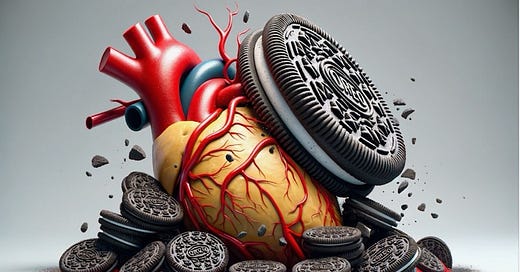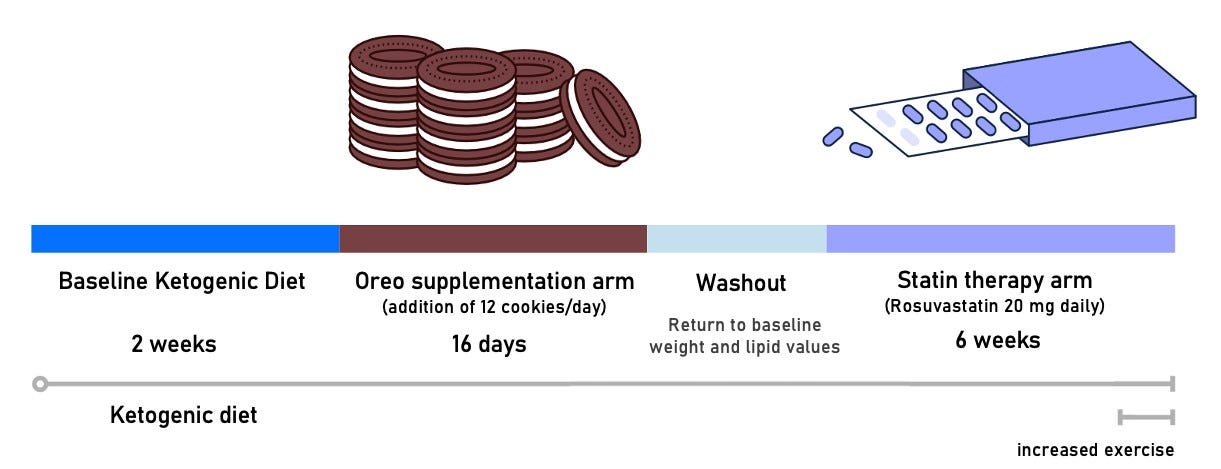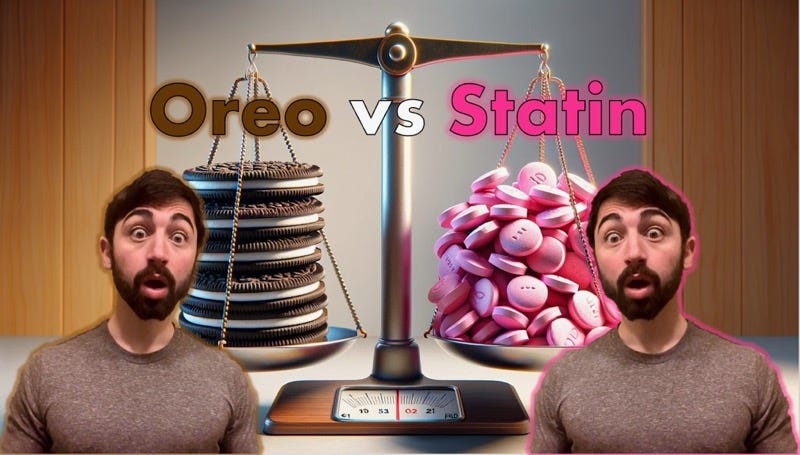2024 Metabolic Health Conference: Oreo Cookie Treatment Lowers LDL Cholesterol More Than High-Intensity Statin Therapy in a Lean Mass Hyper-Responder on a Ketogenic Diet.
I attended the Metabolic Health Conference in Clearwater, Florida, where I saw several exciting presentations regarding metabolic health and well-being. I will write about many of these in the coming weeks. The one that grabbed everyone’s attention was Nick Norwitz’s presentation on lowering LDL cholesterol with Oreo cookies compared to statin medications.
The title was: Oreo Cookie Treatment Lowers LDL Cholesterol More Than High-Intensity Statin Therapy in a Lean Mass Hyper-Responder (LMHR) on a Ketogenic Diet.
A diet of Oreo cookies was twice as effective at reducing LDL or so-called bad cholesterol compared to high-intensity statin therapy. The innovative experiment by Nick Norwitz, a Harvard Medical student with a doctorate in metabolism and nutrition from the University of Oxford, and William Cromwell focused on how a diet of Oreo cookies and statins on cholesterol levels in a unique group of individuals known as “lean mass hyper-responders.”
The term “Lean Mass Hyper-responders” was coined by citizen scientist Dave Feldman (www.cholesterolcode.com). In his infamous white-bread processed meat experiment, Feldman demonstrated this phenomenon many years ago. It’s well known that following a strict ketogenic diet, which is high in fats but low in carbohydrates, leads to an increased LDL cholesterol level in most individuals.
How Nick Did It
Nick is a 27-year-old Harvard Medical School student who adopted a ketogenic diet for the treatment of ulcerative colitis. The ketogenic diet was effective in treating his ulcerative colitis. His other details are outlined in the methods section of the study.
This graphic best illustrates the protocol he used in the study.
Norwtiz’s LDL cholesterol level was 384 mg/dl at the study’s onset. After eating weeks of Oreos, his LDL cholesterol level plummeted to 111 mg/dl. This is a 71% reduction. At face value, most cardiologists would be in awe of this reduction in LDL. Next, Nick stopped the Oreos and returned to his standard ketogenic diet, and his cholesterol level bounced back to 421 mg/dl. After three months back on his ketogenic diet, he took a high dose of statin medication, and the LDL cholesterol was reduced to 284 mg/dl, a 32.5% reduction.
In this case study experiment on a lean mass hyper-responder on a ketogenic diet, Oreo cookie supplementation surprisingly (or not) lowered LDL-C by 273 mg/dL over 16 days, a 71% drop, as compared to a smaller 137 mg/dL peak reduction, a 32.5% drop, with six weeks of high-intensity statin therapy. These findings are consistent with the lipid energy model (LEM) and highlight the need for further studies on this unique lean mass hyper-responder population.
How does cholesterol affect your body?
Traditionally, high cholesterol is when too many lipids or fats exist in your blood. Surpassing the necessary balance of these lipids and fats can lead to plaque buildup and coronary artery blockage. This is known in many circles as the heart cholesterol hypothesis. The hypothesis has undergone scrutiny over the last couple of decades, but still lipid-lowering agents remain the standard of care for America’s greatest killer heart disease. High cholesterol levels are dangerously linked to many serious health problems, including heart diseases like myocardial infarction and stroke. People with high cholesterol and poor lifestyle habits often develop high blood pressure and inflammation in the body, which can eventually be fatal. According to experts, too many lipids in your blood may promote plaque formation and lead to blockages in the coronary artery, impairing heart function.
It’s interesting that at the metabolic health conference, scientist Richard Johnson, MD, highlighted that before the 1900s, we rarely heard of people dying from myocardial infarction. Nowadays, it kills over 400,000 Americans per year and sudden death from myocardial infarction has increased dramatically since 2020, leaving experts scratching their heads.
Exercise, Genetics, and lifestyle factors all play significant roles in fat and cholesterol regulation in the body. For example, smoking and stress are significant factors in dying from heart disease. I even have my own story that I will elaborate on later.
What This Study Tells Us
First, this experiment doesn’t endorse Oreo cookies as a health food or treatment for high cholesterol. Instead, it aims to test a specific scientific prediction based on the lipid energy model coined — The Lipid Energy Model Predicts Oreo Cookie Treatment Will Lower LDL Cholesterol. A meta-analysis strongly showed that an inverse association between BMI and LDL-C change with consumption a LCD; lean individuals experience marked elevation of LDL-C, those with high BMI typically experience no change or a reduction in LDL-C (Sota-Mota, 2024).
What is the Lipid Energy Model?
When lean people adopt carbohydrate-restricted diets, they may develop a lipid profile consisting of elevated LDL-cholesterol (LDL-C) and HDL-cholesterol (HDL-C) with low triglycerides (TGs). The magnitude of this lipid profile correlates with Body Mass Index (BMI), such that those with lower BMI exhibit more significant increases in LDL-C and HDL-C. The Lipid Energy Model (LEM) attempts to explain this metabolic phenomenon by positing that, with carbohydrate restriction in lean persons, the increased dependence on fat in the diet increases hepatic secretion. Peripheral uptake of TG contained within very low-density lipoproteins (VLDL) by an enzyme called lipoprotein lipase, resulting in marked elevations of LDL-C and HDL-C and low TG.
Even if you don’t understand biochemistry, just know that the LEM predicts higher lipid numbers in lean individuals.
For those interested in the LEM, here is the paper by Nick Norwitz:
What Nick Found
The findings of this manuscript are unmistakably curious: Oreo cookie supplementation lowered the LDL-C by 273 mg/dL, a 71% drop from baseline. However, this result is predicted by the LEM.
The LEM proposes that under conditions of carbohydrate restriction sufficient to deplete hepatic glycogen stores and relatively low levels of adiposity, free fatty acids are packaged into VLDL particles in the liver and exported as a systemic fuel trafficking system. This composite physiology yields a triad of elevated LDL-C, HDL-C, and low TG, which characterizes the LMHR lipid triad.
That’s a mouthful, and for better understanding, go back and read about the LEM in PubMed or Dave Feldman’s Cholesterol Code website.
Evidence Is Lacking to Suggest Saturated Fat Is a Driver of the LMHR Phenotype
Increased saturated fat intake is assumed to be a primary dietary driver of increased LDL-C when this occurs in individuals assuming a high-fat KD. However, critical consideration of the available data makes this reductionist explanation insufficient.
During this experiment, saturated fat levels increased in the study’s Oreo arm; nevertheless, LDL-C levels decreased. Additionally, the subject’s previous peak LDL-C was 545 mg/dL on a diet with 1.5 : 7 ratio of saturated : unsaturated fats.
oh la-la – this is a merde-ton of LDL, (as French cardiologists might say.) Most cardiologists would cringe on the spot and send you to the ER without passing go. Perhaps the takeaway is that lipid metabolism is way more complex and dynamic than traditionally thought.
Norwitz even showed that a mild increase in exercise elevated his LDL’s. Indeed, LDL-C increased by ~50 mg/dL following an increase in daily step count by ~10,000 additional steps/day, consistent with the LEM.
Scientists like Feldman and Norwitz are motivated, meticulous, and obsessive in how they conduct their experiments. I’ve had dinner with Dave many times; eating with Dave, you have to get used to him photographing and documenting every single meal. Most would think this is over the top, but these guys are serious; they want to erase any doubts about their research.
And even more importantly, they are letting the truth of science take them wherever it goes. This is how authentic science is accomplished. They are not big pharma companies directing how they want the research to go or strategically stopping the experiment to avoid showing a negative side effect. In this sense, they have no horse in the game.
One advantage of this experiment was the rigor with which it was conducted. The individual subject was capable and motivated to assume a standardized, tracked diet for a long duration, adopt burdensome interventions that may be unethical to impose on recruited volunteers, and rigorously collect data. Norwitz and Feldman routinely submit themselves to weekly blood -draws for lab testing—more than most people.
Ethical Considerations of Self-Experimentation and the Citizen Scientist Movement
Oreo supplementation should not be considered a beneficial health intervention, and long-term consumption of refined carbohydrates would have negative health consequences. This experiment was a “metabolic demonstration.” Accordingly, the data presented in this case study experiment should not imply any form of health advice.
However, while the perception that “playing” with a subject’s cholesterol levels is ethically questionable, the case at hand deserves special consideration. First, the subject and the primary investigator are the same person, and the experiment at hand would have been conducted irrespective of whether the resulting data were peer-reviewed and published. The fact that these results are published merely makes data available for the benefit of other scientists and curious clinicians.
Second, interventions are considered safe, by most standards. Oreo cookies are not healthy food, but the general population consumes foodstuff like Oreo’s routinely and without fanfare. That the subject, a 27-year-old male, ate Oreos is not unusual, unethical, or considered particularly unsafe over 16 days. Conversely, lowering LDL-C via high-intensity statin therapy aligns with present-day standard medical care.
In general, the ethics of self-experimentation and ‘Citizen Science’ (a term referring to a movement among the public towards engaging in self-experimentation, generally in health and fitness) is a topic that deserves further study.
Why this Study Matters
The significance of this study lies in the recognition of a complex issue related to lipids and the pursuit of a deeper understanding. Norwitz and Feldman are gripped by the problem that lipids are complex, and there’s more to the story. Neither one of them chose this path voluntarily. Specifically, the problem came knocking, and they had the choice of whether to open the door. The LEM is something that tripped them into pause, and they couldn’t shake it. Biblically, this is the story of the Burning Bush Moses saw.
Nick, Dave, and many others have found themselves humbly searching for the problem and the solution. And humbly because you must admit that you have a problem and don’t know the answer. And then, as they have opened themselves up, they’ve gotten revelations about what’s happening. Maybe they’re right, maybe they’re wrong. But they are setting the standard for how science could be done. Their experiences lend themselves to how we think and come up with ideas. They have received criticisms from people like Peter Attia and Thomas Dayspring, who have dogged the LEM to the extent that they say it’s level 5 evidence. In engineering terms, this is akin to going out on a limb, and the limb breaking and falling the ground. Just to be clear, there are randomized controlled studies and meta-analysis showing the validity of the LEM (Norwitz, 2023).
Philosophical Question – How Hypothesis are Generated
How is it that human beings tend to think? On the topic of normative thought, Swiss Philosopher Carl Jung said, “The typical person doesn’t think.” What happens to the typical person is that thoughts appear to them, and they accept them without further investigation or reflection. This emphasizes the prevalence of automatic or unexamined thinking. This is why people in science say that they “thought up the hypothesis,” which isn’t much of an explanation.
Scientists “thinking up hypothesis” touches on the creative and unconscious nature of idea generation. The emergence of new ideas are mysterious. For example, what does one mean by, they “thought about it?” Previously, they didn’t know the hypothesis, and today, do you know it? And so, how did they not know it then, and how do they know it now? Is it that new idea manifested itself? And the answer will always be – “it came to me.” From where exactly did it come?
The sequence described involves a progression from the emergence of an idea, which underscores the interplay between unconscious, intuitive, and conscious, analytic thinking. Scientists rarely talk about how the hypothesis generation process works. They talk about the observable data, but they don’t talk about the mechanism by which the investigative question was formulated. And even more how, they must let the truth guide them and report whatever comes about. That’s a vast domain of unconsciousness.
The next part of the sequence is a revelation, an insight; it’ll be something that strikes you as probable. And then, once the revelation manifests itself, you can analyze it critically and subject it to further empirical analysis and criticism of others. In essence, Jung’s perspective invites us to consider the source and nature of their thoughts, encouraging a deeper awareness with the thinking process.
Refs
Norwitz NG, Cromwell WC. Oreo Cookie Treatment Lowers LDL Cholesterol More Than High-Intensity Statin therapy in a Lean Mass Hyper-Responder on a Ketogenic Diet: A Curious Crossover Experiment. Metabolites. 2024 Jan 22;14(1):73. doi: 10.3390/metabo14010073. PMID: 38276308; PMCID: PMC10818743.
Norwitz NG, Soto-Mota A, Kaplan B, Ludwig DS, Budoff M, Kontush A, Feldman D. The Lipid Energy Model: Reimagining Lipoprotein Function in the Context of Carbohydrate-Restricted Diets. Metabolites. 2022 May 20;12(5):460. doi: 10.3390/metabo12050460. PMID: 35629964; PMCID: PMC9147253.
Soto-Mota A, Flores-Jurado Y, Norwitz NG, Feldman D, Pereira MA, Danaei G, Ludwig DS. Increased LDL-cholesterol on a low-carbohydrate diet in adults with normal but not high body weight: a meta-analysis. Am J Clin Nutr. 2024 Jan 16:S0002-9165(24)00009-1. doi: 10.1016/j.ajcnut.2024.01.009. Epub ahead of print. PMID: 38237807.








